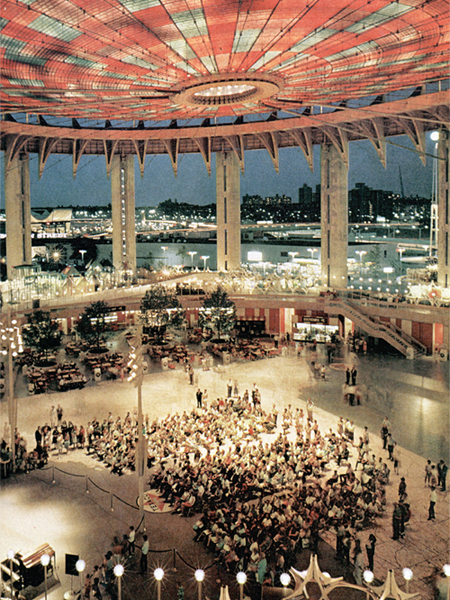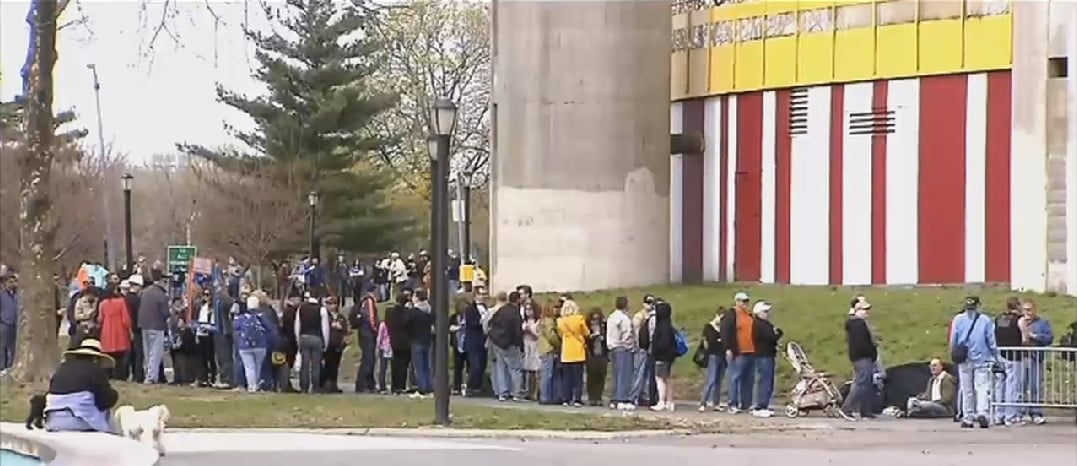Art & Exhibitions
50 Years Later, See the Site of New York’s World’s Fair and Warhol’s Censored Mural
The 1964 World's Fair opened 50 years ago today; then its Pop art mural was censored.

The 1964 World's Fair opened 50 years ago today; then its Pop art mural was censored.

Sarah Cascone

Today, in celebration of the 50th anniversary of the opening of 1964 World’s Fair, tourists are welcome to visit the New York State Pavilion at Flushing Meadows Corona Park for the first time in decades, report Arch Daily and DNAinfo. Nearby, at the Queens Museum, an exhibition will recreate an Andy Warhol exhibition that was censored during the original fair, as reported by AFA News.

Crowds on line to tour the New York State Pavilion on April 22, 2014, the 50th anniversary of the opening day of the World’s Fair.
Photo: video still from CBS New York.
As originally envisioned, the curved facade of the Pavilion’s Circarama theater, adjacent to the Tent of Tomorrow, was to feature a large-scale mural by Warhol. The artist’s subject matter, however, was a sensitive one: mugshots of the state’s 13 most wanted criminals.
Rather than risk upsetting families with young children, or the local Italian community (7 of the 13 men were of Italian descent), Governor Nelson Rockefeller gave the order to cover the work in silver paint.
Opening April 27 at the Queens Museum, “13 Most Wanted Men: Andy Warhol and the 1964 World’s Fair” will include archival materials and documents related to the creation and ultimate censorship of the work, including a letter from Warhol in which he agrees to have the piece painted over.
The show was organized by the Queens Museum in conjunction with the Andy Warhol Museum. Celebrating its 20th anniversary this year, the Pittsburgh institution recently announced that it would be redesigning its galleries and rehanging its collection (see report from Artdaily).
Although Warhol offered a grid of Robert Moses portraits as a replacement work, architect Philip Johnson—who had designed the Pavilion and commissioned the artist’s involvement—rejected the proposal as inappropriate. The aborted 13 Most Wanted Men became Warhol’s last public work.
Later that year, Warhol used the screens from the original 13 Most Wanted Men mural to recreate the portraits. Nine of these canvases will appear at the Queens Museum exhibit, the first time they have been publicly shown together since their creation.

The Tent of Tomorrow in recent years.
Photo: courtesy Wikimedia Commons.
The Pavilion, for its part, has seen better days. The Tent of Tomorrow has recently been repainted, but is in a general state of disrepair, although the Queens Theater in the Park remains open. Vacant since 1976, when the roof became unstable, the Tent had served for a time as a roller rink after the fair’s end.
The structure’s future is uncertain—it may be torn down due to the prohibitive cost of necessary repairs, according to the Huffington Post. The People for the Pavilion organization is working to preserve the historic building. The cause received a boost today as the building was declared one of the country’s 44 National Treasures by the National Trust For Historic Preservation, CBS New York reports.

The Tent of Tomorrow during the fair.
Photo: courtesy People for the Pavillion website.
In their heyday, the fairgrounds were home to many more buildings, imaginative renderings of the future, and a herd of life-sized dinosaur sculptures sponsored by the Port Authority. (See vintage photos at the Huffington Post.)
“13 Most Wanted Men: Andy Warhol and the 1964 World’s Fair” will be on view at the Queens Museum through September 7, before travelling to the Andy Warhol Museum (September 27, 2014–January 5, 2015).

Andy Warhol, 13 Most Wanted Men (1964), 20 by 20 foot mural mounted on the curved facade of the New York State Pavilion at the 1964 New York World’s Fair in Flushing Meadow Corona Park, Queens, New York. The photo was taken in April, before mounting political pressure led to censors painting over the mural, which depicted mug shots of the NYPD’s 13 most-wanted criminals.
Photo: AP, courtesy the Andy Warhol Foundation for the Visual Arts, Inc. and the Artists Rights Society.